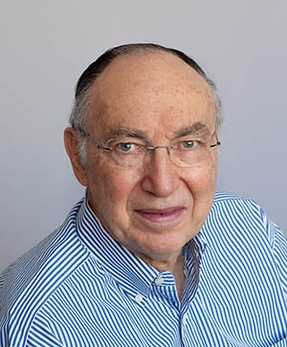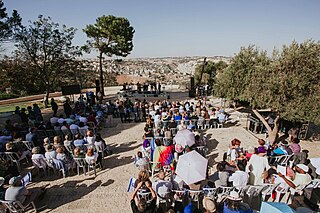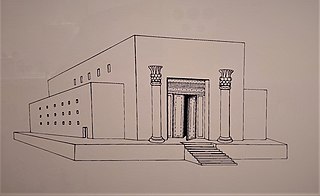Jerusalem Christian Review is a newspaper for Christians published in Jerusalem. [1]
Contents

Jerusalem Christian Review is a newspaper for Christians published in Jerusalem. [1]

It was founded in April 1993 and reports on archaeological discoveries which shed light on the biblical narrative. It is published by the non-profit Jerusalem Bible Holy-Land Center, an educational foundation formed in 1968 by a group of Christian and Jewish scholars. [2]
Jerusalem Christian Review's Managing Editor is biblical historian Dan Mazar, [3] the author of numerous works on Christian-Israel relations and Second Temple archaeology. Mazar is also a former chairman of the politically powerful advocacy group, the Christian Mid-East Conference. [4]
The newspaper includes contributions and endorsements by well known Christian and political figures, including Christian psychologist James Dobson, Christian Broadcasting Network president Pat Robertson, Evangelist Franklin Graham, former Southern Baptist president Charles Stanley and Seventh-day Adventist leader George Vandeman. In Volume 12, Issue 2, Israeli Prime Minister Benjamin Netanyahu writes to the readers of the Jerusalem Christian Review, explaining that, "The... Review connects the history of Israel to today's realities of the Middle East."
Published on each issue's front page is the Jerusalem Christian Review's slogan: New discoveries of the Bible, Jesus, and the First Church.
In Volume 12, Issue 1, of the newspaper, former Israeli premier Yitzhak Shamir writes that,"the Jerusalem Christian Review, Jerusalem's leading Christian newspaper... reports on archaeological and historical discoveries [in Israel]: its insightful commentary on the past in its relevance to the present."
Among the articles of note published in recent editions are:
The Jerusalem Christian Review was responsible for organizing the first globally publicized "link of prayer" for peace from Jerusalem (See World Day of Prayer). This was in June 1993 and the event included more than one hundred Christian and political leaders from around the world broadcast live by satellite and radio from Jerusalem.
Hosted by Jerusalem Christian Review Managing Editor Dan Mazar, parts of the Global Prayer were also shown on the CNN, CBS, and ABC television networks and almost 120 other television stations worldwide. The Prayer Link began from Los Angeles, California with a prayer from the former U.S. president, Ronald Reagan: "I join my friends at the Jerusalem Christian Review... for this very special day. A day dedicated to prayer..." said the former US president and governor of the State of California. The "prayer link" also included prayers of political figures live by satellite from 5 continents. Leaders such as Jack Kemp, Jeane Kirkpatrick and numerous U.S. Senators, as well as former Australian Prime Minister Bob Hawke all prayed for the "Peace of Jerusalem". Also included were Christian evangelists Billy Graham, Pat Robertson, Jerry Falwell and James Dobson, along with denominational leaders from Europe, Africa, South America and Asia. [5]

David was a king of ancient Israel and Judah and the third king of the United Monarchy, according to the Hebrew Bible and Old Testament.

The Kingdom of Judah was an Israelite kingdom of the Southern Levant during the Iron Age. Centered in the highlands to the west of the Dead Sea, the kingdom's capital was Jerusalem. It was ruled by the Davidic line for four centuries. Jews are named after Judah, and primarily descend from people who lived in the region.

Marion Gordon "Pat" Robertson was an American media mogul, televangelist, political commentator, presidential candidate, and charismatic minister. Robertson advocated a conservative Christian ideology and was known for his involvement in Republican Party politics. He was associated with the Charismatic movement within Protestant evangelicalism. He served as head of Regent University and of the Christian Broadcasting Network (CBN).

The City of David, known locally mostly as Wadi Hilweh, is the name given to an archaeological site considered by most scholars to be the original settlement core of Jerusalem during the Bronze and Iron Ages. It is situated on southern part of the eastern ridge of ancient Jerusalem, west of the Kidron Valley and east of the Tyropoeon Valley, to the immediate south of the Temple Mount.
The historicity of the Bible is the question of the Bible's relationship to history—covering not just the Bible's acceptability as history but also the ability to understand the literary forms of biblical narrative. Questions on biblical historicity are typically separated into evaluations of whether the Old Testament and Hebrew Bible accurately record the history of ancient Israel and Judah and the second Temple period, and whether the Christian New Testament is an accurate record of the historical Jesus and of the Apostolic Age. This tends to vary depending upon the opinion of the scholar.

Amihai "Ami" Mazar is an Israeli archaeologist. Born in Haifa, Israel, he has been since 1994 a professor at the Institute of Archaeology of the Hebrew University of Jerusalem, holding the Eleazer Sukenik Chair in the Archaeology of Israel.

Israel Finkelstein is an Israeli archaeologist, professor emeritus at Tel Aviv University and the head of the School of Archaeology and Maritime Cultures at the University of Haifa. Finkelstein is active in the archaeology of the Levant and is an applicant of archaeological data in reconstructing biblical history. Finkelstein is the current excavator of Megiddo, a key site for the study of the Bronze and Iron Ages in the Levant.

Benjamin Mazar was a pioneering Israeli historian, recognized as the "dean" of biblical archaeologists. He shared the national passion for the archaeology of Israel that also attracts considerable international interest due to the region's biblical links. He is known for his excavations at the most significant biblical site in Israel: south and south west of the Temple Mount in Jerusalem. In 1932 he conducted the first archaeological excavation under Jewish auspices in Israel at Beit She'arim and in 1948 was the first archaeologist to receive a permit granted by the new State of Israel. Mazar was trained as an Assyriologist and was an expert on biblical history, authoring more than 100 publications on the subject. He developed the field of historical geography of Israel. For decades he served as the chairman of the Israel Exploration Society and of the Archaeological Council of Israel. Between 1951 and 1977, Mazar served as Professor of Biblical History and Archaeology at the Hebrew University of Jerusalem. In 1952 he became Rector of the university and later its president for eight years commencing in 1953.

Biblical archaeology is an academic school and a subset of Biblical studies and Levantine archaeology. Biblical archaeology studies archaeological sites from the Ancient Near East and especially the Holy Land, from biblical times.

According to the Deuteronomistic history in the Hebrew Bible, a United Monarchy or United Kingdom of Israel existed under the reigns of Saul, Eshbaal, David, and Solomon, encompassing the territories of both the later kingdoms of Judah and Israel.

Eilat Mazar was an Israeli archaeologist. She specialized in Jerusalem and Phoenician archaeology. She was also a key person in Biblical archaeology noted for her discovery of the Large Stone Structure, which she surmised to be the palace of King David.

The Bible Unearthed: Archaeology's New Vision of Ancient Israel and the Origin of Its Sacred Texts, a book by Israel Finkelstein, Professor of Archaeology at Tel Aviv University, and Neil Asher Silberman, an archaeologist, historian and contributing editor to Archaeology Magazine published in January 2001 by Simon & Schuster using its Free Press imprint and reprinted in June 2002 using its Touchstone imprint, discusses the archaeology of Israel and its relationship to the origins and content of the Hebrew Bible.

Hershel Shanks was an American lawyer and amateur biblical archaeologist who was the founder and long-time editor of the Biblical Archaeology Review.

The Day of Prayer for the Peace of Jerusalem is a prayer meeting organized by Pentecostal evangelists Jack W. Hayford and Robert Stearns through their organization "Eagles Wings". They annually invite people around the world to pray for Jerusalem on the first Sunday of every October, close to the time of Yom Kippur. The first prayer meeting organized by this group occurred in 2004.

Jerusalem's role in first-century Christianity, during the ministry of Jesus and the Apostolic Age, as recorded in the New Testament, gives it great importance, both culturally and religiously, in Christianity. Jerusalem is generally considered the cradle of Christianity.
The Biblical Archaeology Society was established in 1974 by American lawyer Hershel Shanks, as a non-sectarian organisation that supports and promotes biblical archaeology. Its current publications include the Biblical Archaeology Review, whilst previously circulating the Bible Review (1985–2005) and Archaeology Odyssey (1998–2006). The Biblical Archaeology Society also publishes books about biblical archaeology aimed at a general readership. The Society has, for more than 45 years, run seminars and tours offering an opportunity to learn directly from world-renowned archaeologists and scholars. It also produced videos (DVD) and CDs on archaeology and biblical archaeology.

Avraham Biran was an Israeli archaeologist, best known for heading excavations at Tel Dan in northern Israel. He headed the Institute of Archaeology at Hebrew Union College in Jerusalem for many years.
A Day of Prayer is a day allocated to prayer, either by leaders of religions or the general public, for a specific purpose. Such days are usually ecumenical in nature, and are usually are treated as commemorative in nature, rather than as actual liturgical feast days or memorials.

Solomon's Temple, also known as the First Temple, was a biblical Temple in Jerusalem believed to have existed between the 10th and 6th centuries BCE. Its description is largely based on narratives in the Hebrew Bible, in which it was commissioned by biblical king Solomon before being destroyed during the Siege of Jerusalem by Nebuchadnezzar II of the Neo-Babylonian Empire in 587 BCE. No remains of the destroyed temple have ever been found. Most modern scholars agree that the First Temple existed on the Temple Mount in Jerusalem by the time of the Babylonian siege, and there is significant debate among scholars over the date of its construction and the identity of its builder.
Views of the Biblical World is a five-volume set of reference books published in 1959 by the International Publishing Company J-M, of Israel. Also published under the name World of the Bible, the series was acclaimed at the time as a landmark. It was the first publication dedicated exclusively to the correlation of archaeological and historical discoveries in Palestine with biblical texts.